|
FAQs about Marine Crab Identification
13
Related Articles: Crabs, Hermit
Crabs,
Related FAQs: SW
Crab Identification 1, SW Crab ID
2, SW Crab ID 3, SW Crab ID 4, SW
Crab ID 6, Marine Crab ID 7,
Marine Crab ID 8, Marine Crab ID 9, Marine
Crab ID 10, Marine
Crab ID 11, Marine
Crab ID 12, SW Crab ID 14,
SW Crab ID 15, SW Crab ID 16, SW
Crab ID 17, SW Crab ID 18,
SW Crab ID 19,
SW Crab ID 20,
SW Crab ID 21,
SW Crab ID
22,
& Marine Invertebrate
identification, Marine Crabs
1, Marine Crabs
2, Marine Crabs 3, Marine Crabs 4, & Crab Behavior, Marine Crab
Selection, Marine Crab
Compatibility, Marine Crab
Systems, Marine Crab
Feeding, Marine Crab
Reproduction, Marine Crab
Disease, Micro-Crustaceans,
Amphipods, Copepods, Mysids, Hermit
Crabs, Shrimps,
Cleaner
Shrimps, Banded Coral
Shrimp, Mantis
Shrimp, Anemone
Eating Shrimp, Crustacean Identification, Crustacean Selection, Crustacean Behavior, Crustacean Compatibility, Crustacean Systems, Crustacean Feeding, Crustacean Disease, Crustacean Reproduction,
|
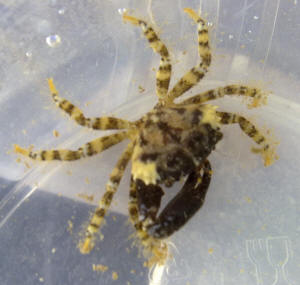
|
|
Re: Crab ID - 3/20/09
<Hello again>
The crab came in my live rock whenever I got it. My live rock is
premium Fiji rock.
<That's great, thanks.>
The crab is about an inch from legs to legs.
<Okay>
I have a few pictures of his claws and I'm still trying to
get the top view picture but he looks just like a pebble.
<Yep, that shot can be a challenge when the crab is still in
the tank. Sometimes you get lucky, though.>
You can't see his legs or claws from the top.
<Gotcha>
I've attached a few different angles of his claws.
<Thanks, he's a feisty little thing isn't he! The good
news is that the new photos show a bit more of the body and legs,
which gives us a few clues. Given the theory that form follows
function, those heavy claws appear to be well adapted for
crushing. That is, this is likely a crab that includes various
bivalves/clams, other sessile organisms, crustaceans, possibly
gastropods/snails, etc in its diet. Thankfully, it's not a
crab built for speed, so it's not as much a direct threat to
fish as say, a Sally Lightfoot (Percnon gibbesi). That's not
to say, though, that it's no threat -- especially if/when it
gets larger. If the opportunity arises for it to nab a sleeping
fish, it's hasta la vista baby.
Unfortunately, I'm still unable to narrow the ID down to
species level, but I'm thinking what you have is a Xanthid of
some sort (family: Xanthidae). I've got a terrific link for
you to look through which may enable you to narrow things
further. It lists tropical crabs of the central Pacific
region/French Polynesia. Fiji is a good bit west, but it's
the best I can do as far finding online photos of crabs in that
general area of the world. The main thing is that it will give
you a good opportunity to see and compare various genera within
the family Xanthidae. Look through the photos and see if you can
find features in common with your little crab. I saw several that
looked similar, but I'd have to have the crab right in front
of me to take it any further. Just keep in mind when you're
looking through the photos that color can vary quite a bit. The
main criteria to look for include carapace shape/depth/texture
(is it smooth/rumpled/hairy), whether the edge of the carapace is
smooth, wavy, or if there are any spines/protrusions present (if
so, how many), eye spacing, length/shape of claws (are there any
spines/other protrusions present), leg shape and how hairy (if at
all), and overall body posture (how and where the legs/claws are
positioned/held in relation to the carapace). As you can see,
there are quite a few features to look for! I'm hoping
though, that you'll be able to determine at least the genus
of your little crab. Here you go:
http://decapoda.free.fr/search_result.php?submit32=Submit&spname=&auname=¥ame=&gename=&faname=
xanthidae&ioname=&medium=&Substrat=&ile=&vertical=&pmin=&pmax=&auteur=
>
Thank you
<You're very welcome. Take care and good luck!
Lynn>
|
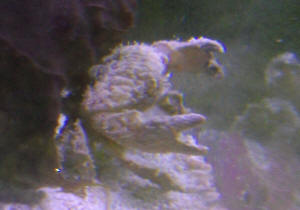 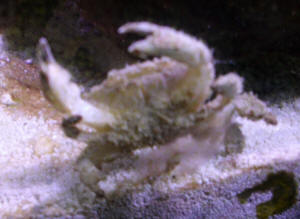 |
Re: Crab ID - 3/20/09
<Hello again!>
Thank you so much.
<It was a real pleasure.>
I love the wetwebmedia.com website. It is the most informative site
I've come across.
<On behalf of Bob and the crew, past and present, I thank
you!>
I use it all the time.
<Me too!>
The closest thing I found to the crab is an Eroded Crab.
<Neat. The common name Eroded Crab, or Eroded Mud Crab, is
usually attributed to crabs in the genus Glyptoxanthus, a Xanthid
with an all over rumpled/bumpy texture. Even the legs and claws are
heavily textured. It's an odd but neat looking little
crab.>
Again thank you for all of your help, it's much
appreciated.
<You're very welcome. Take care, Lynn> |
|
Crab ID please if possible 3/1/09
Hi folks,
<Steve>
Long time reader of your fabulous site and as I am starting to go
bog eyed searching for info on a crab I've found, I decided
an email was worth a shot.
<Okay!>
In my coral tank, we found the attached crab and would like to
know essentially if its safe to go back in there, or leave in the
sump, or transfer to my fish only.
<Mmm>
Coral tank ( with live rock from Fiji I think) (400 litres) has
various SPS and LPS corals in, pair of common clowns with a Malu
Anemone, mandarin dragonet, yellow tang, coral beauty, saffron
coral goby, yellow goby with shrimp friend, magenta Dottyback,
cleaner shrimps, blood shrimps, peppermint shrimps (with an
allergy to Aiptasia!), 2 Sandsifter starfish, 2 emerald crabs and
2 scarlet leg hermits. Plus of course a few snails.
We haven't lost anything and the little stripey crab
(carapace is about half an inch across) just seems to graze but
I'm aware of the potential for problems if it isn't
really suitable for the tank. I'm also slightly concerned the
emeralds are a future problem waiting to occur. Any advice on
this and any clue on my newly found crab?
<Only a guess... to the family... the body and claw-shape...
looks like a Grapsid to me... only time can/will tell whether it
gets too big, too adventurous for you to allow in your main
display>
Oh my Fish only (with live rock) (500 litres) has 2 bubble tip
anemones, 2 tomato clowns, majestic angel, blue cheeked goby,
purple tang, blue spotted puffer fish, 2 hovercraft cow fish,
<These last two might well consume this crab during
molting>
long nosed butterfly (allergic to Aiptasia...), regal tang, sally
lightfoot, bristle starfish, blue banded hermits, a huge rock
hermit, 2 sand sifter starfish.
Many thanks in advance,
Steve Witty
<I'd take a look, see, enjoy approach here with this
Decapod. Bob Fenner>
|
 |
|
Crab id question 2/22/09
Hi,
<John>
I'm hoping to find out what type of crab this may be. He
probably came in with live rock from around the Barrier Reef and
has been seen in the tank for the last 2 - 3 months. In that time
he has grown at least 50% bigger and is now a size where his main
body excl legs is about 30-35 mm across.
<I see>
The tank is 100 litres and has a few fish, Trochus snails and
smaller hermit crabs (which he definitely regards as
edible!).
<Oh yes>
Apart from that nothing has gone missing, although something is
nipping at the Xenias. He is very shy, generally he moves about
slowly picking at the rocks and does not like to interact with
the fish. He is fond of shrimp pellets, and he can move really
fast when anything approaches (so he's very hard to
photograph, sorry about picture quality). As he grows his main
claws seem to be fattening up and going blacker on the tips.
<I see this as well>
Overall he's a kind of beige/yellow but his (or her) body is
covered with sort of little tufts of darker hair or spines.
Haven't seen its eyes. I have a concern that as he grows it
could become a problem but at present there's no huge
problem...just some nervous hermits!
Regards and thanks, John
<This appears to be a Round Crab (family Xanthidae) of some
sort... by the carapace shape and darkened claw tips... I'd
keep your eye on it... will become more predaceous, opportunistic
with time. Bob Fenner>
|
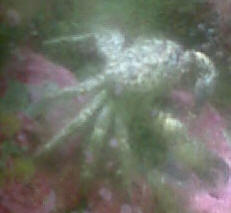 |
|
Crab ID: Mithracid - 2/13/09
Greetings,
<Hi Jack, Lynn here this evening.>
The attached pics are of a crab that came with a piece of
live rock. It is less than an inch in size and looks to me as the
same shape as an emerald, but as you can see it is red.
<Yep, it's fellow clinging crab in the same family
(Mithracidae), most likely Mithrax hispidus or Mithraculus
forceps. Please see the following photos for comparison.
M. hispidus:
http://www.dnr.sc.gov/marine/sertc/images/photo%20gallery/Mithrax%20hispidus.jpg
M. forceps:
http://www.dnr.sc.gov/marine/sertc/images/photo%20gallery/Mithraculus_forceps_S806.jpg
http://www.wetwebmedia.com/Arthropoda/CrustaceanPIX/SWCrabs/SWCrabs2.htm
>
Is this one that I should get rid of? I have mostly a fish only
tank but I do have some soft corals and some Zoanthids.
<I'd leave it, unless/until you see evidence of
damage/predation. No crab is completely reef-safe but
Mithraculus/Mithrax spp. have a better track record than most.
He'll probably spend most of his time picking at bits of
algae and leftover food here and there on the rocks and about the
tank. You can also supplement the food supply though, with meaty
bits of marine origin or sinking pellets. Keeping the crab well
fed will help lessen the chances of him getting into trouble. For
more information on these crabs, please see the following link:
http://www.wetwebmedia.com/mithraxfaqs.htm >
Any information will be very appreciated.
Jack
<You're very welcome. Take care, Lynn>
|
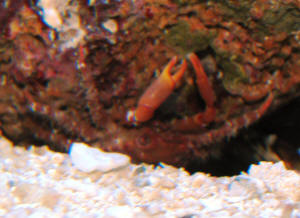 |
ID Please: Likely Mithracid or Pilumnid Crab --
1/24/09
Hello Bob
<Hello Harald, Lynn here this afternoon.>
My Name is Harald, I come from Germany.
<Wunderbar!>
Maybe somebody can tell me what crab this is?
<The flattened tips of the claws are typical of Mithraculus/Mithrax
spp. crabs (family: Mitracidae). However, I've occasionally seen
similar in the family Pilumnidae. Please see the following links for
examples:
Family Mitracidae:
http://www.nhm.org/guana/bvi-invt/bvi-surv/crab-g03.htm
Family Pilumnidae (towards the bottom of the page):
http://www.nhm.org/guana/bvi-invt/bvi-surv/crab-g06.htm
Thank you beforehand.
Liebe GrüÃe
< Gern geschehen! Lynn>
Copyright issue with query photo
Hi Bob,
I just replied to a query with an attached copyright photo that does
not appear to be that of the querior (Harald). The title is: ID Please:
Likely Mithracid or Pilumnid Crab - 1/24/09. The copyright name on the
photo is "rieros Miniriff". I looked the person up on the
'net and it appears to be a Thomas Tögel :
http://riero1971.de/html/impressum.html ). It's possible that
Harald received permission to use the photo, but who knows. Anyway, I
just wanted to give you a head's up.
Thanks and have a great weekend!
-Lynn
Ahh, thank you Lynn. Will be sure to not post it/this. Cheers,
BobF.
|
I.D. For Strange Hitch-Hiking Crab Or
Spider -- 01/17/09
Hi,
<<Hello>>
Thank you for your great site.
<<Quite welcome>>
I work at a LFS here in Hawaii,
<<Neat!>>
but have only been keeping salt water tanks for about a year and
1/2. Recently this 8 legged crab/spider (?) showed up.
<<I think I've seen these in the rocks along the
shoreline around Kona on the Big Island. It looks to be Percnon
gibbesi, the Nimble Spray Crab (see here, down the page a little
more than half:
http://www.wetwebmedia.com/marine/inverts/arthropoda/crabs/swcrabs.htm
). And while not the true Sally Lightfoot Crab (Grapsus grapsus),
it is often seen/sold in the hobby under this common
name>>
His legs are banded with yellow and the body looks to be almost
clear except for some fluorescent greenish-blue markings. The
legs are 3 times as long as the body. From what I can tell he
mainly stays on one live rock I have and probably came in on
it.
<<Probably>>
I picked most of these rocks from near the shore here.
<<Mmm'¦ I didn't think it was legal to
collect live rock in Hawai'i. Last I knew, one could only
gather 'dry' rock from above the high-tide line, and then
only take what a 5gal bucket will hold, per day>>
I looked all over your sight and also tried some other sites. I
thought he might be a sea spider but he is about 2 inches in
diameter already, I didn't get the impression from your site
that they grew that big.
<<Correct>>
When I first noticed him, he was only about 3/4 of an inch. (He
seems to mind his own business but once in a while when another
one of the inhabitants gets close to him he does seem to move
aggressively towards them.) Hope the pictures come through.
<<They did>>
Thanks for any help.
<<Happy to share>>
I often peruse your site for helpful answers to the questions the
customers ask.
<<Excellent>>
Any I.D. or info would help.
Mary
<<Take a look at the link and see what you think. Regards,
EricR>>
|
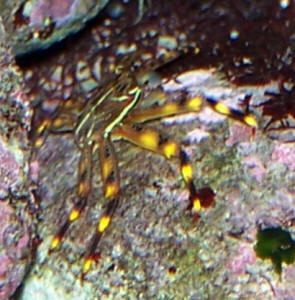 |
I.D. of Crab -- 01/17/09
Hi WWM Crew,
<<Hey Mary>>
I just sent you an email a few minutes ago and was checking your
website and I believe I found the crab.
<<Ah yes, I believe I just responded to that
query>>
It looks like the image of Percnon planissimum (Flat Rock Crab)
you have pictured.
<<Hmm'¦ I still think it looks more like Percnon
gibbesi in the photo just above P. planissimum (compare the
markings on the legs/carapace with those in your
photo)>>
Could you tell me about them?
<<Opportunistic omnivores'¦ Large specimens can
be a threat to small fishes>>
I have a FOWLER tank that contains a small coral beauty dwarf
angel, a small raccoon butterfly, a bicolor blenny and a scooter
blenny (also a Lysmata amboinensis cleaner shrimp). Anyway, is
this Flat Rock Crab alright to keep,
<<I wouldn't (not a big fan of most crabs for their too
opportunistic nature), but that is up to you>>
he is extremely quick.
<<It is probably not a big threat right now to anything
listed here other than maybe the shrimp. But that will likely
change as it gets larger. Some of the literature on the NET lists
these as fairly small species (4cm), but I could swear I've
seen them around the Big Island with carapaces that would measure
two or three inches across>>
He seems to be getting plenty to eat and has probably doubled in
size since I first noticed him 2 months ago.
<<Do keep an eye on this>>
Thanks again.
Mary
<<Cheers, EricR>>
Re: I.D. of Crab -- 1/19/09
Hi Eric R,
<<Hiya Mary>>
Thanks for your reply.
<<Quite welcome 'hope it was helpful>>
Yes I agree with you it does look like Percnon gibbesi.
<<Ah!>>
And I think I will remove him the next time I do a major water
change; which will be soon because there is one other boxy crab
with black pinchers I want out.
<<Indeed'¦ Fascinating creatures,
but'¦>>
Yes, most of the rock I collected one piece at a time over a one
and 1/2 year stretch. Mostly in the upper tidal area around the
shore line. I try not to pick up any that have anything alive on
them. And even though the pieces have begun to dry out, sometimes
after curing there is still live stuff deep in the rock. The
owner of the LFS had a permit to make his own live rock from
crushed coral and cement.
<<Even this requires a permit?
Amazing'¦>>
So early on I seeded my aquarium and the rocks I picked up with
that and so for all practical purposes it is now live rock. Again
thank you for all your help and your advice. Wish me luck in
catching that critter-they are fast.
<<Perhaps some bait in a glass jar positioned near the
rock 'good luck!>>
Aloha & mahalo, Mary
<< A hui hou'¦ EricR>>
|
|
|

